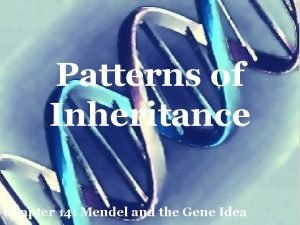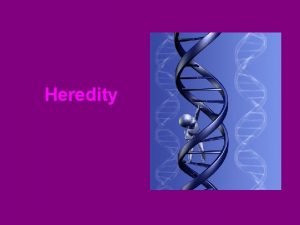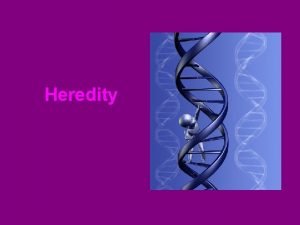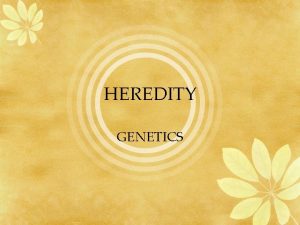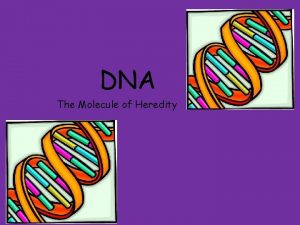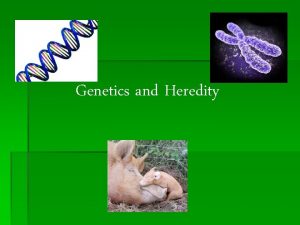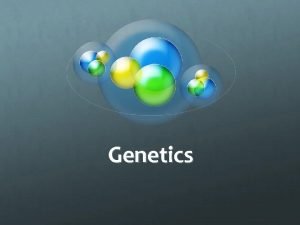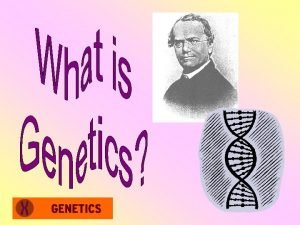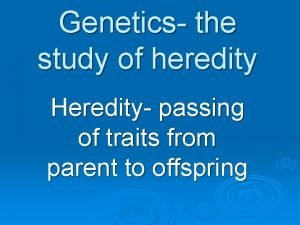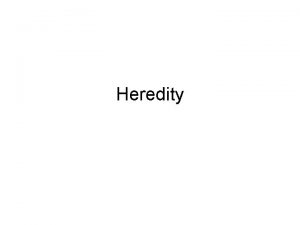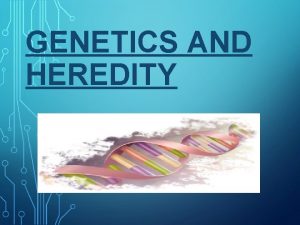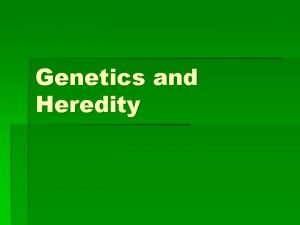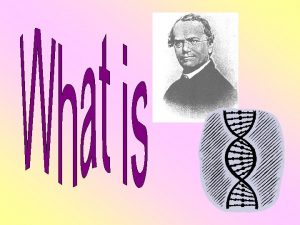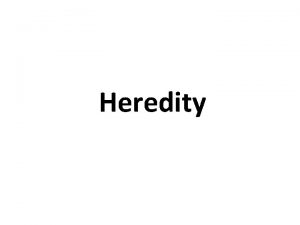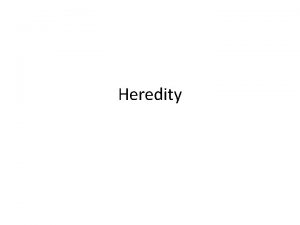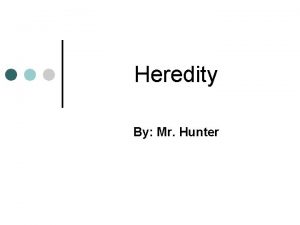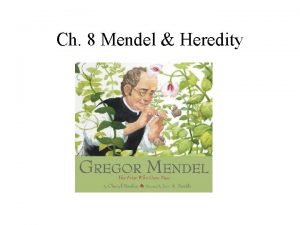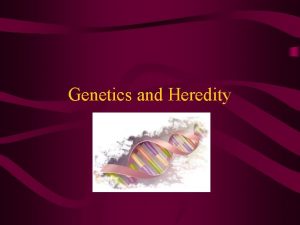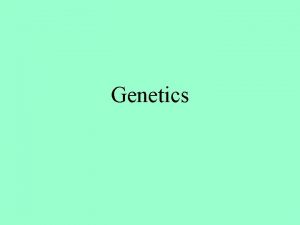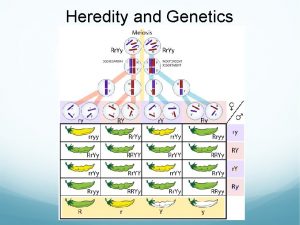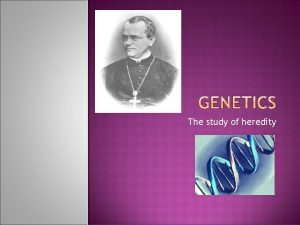Chapter 8 Heredity Heredity is the passing of










































- Slides: 42

Chapter 8 - Heredity

• Heredity – is the passing of traits from parent to offspring. • We call these “inherited traits”.

Inherited Traits • Living things inherit many traits, or characteristics from their parents. • Recall that _____, determine the inherited traits of an organism. • Traits are determined by the genes you receive from your parents.

Genotype vs. Phenotype • Genotype – “genetic makeup” of an organism. • Phenotype –– the way an organism looks and behaves as a result of its genotype ---“physical makeup”. • Genotype DETERMINES phenotype

Chromosomes • Genes are located on structures called chromosomes. • Cells of different kinds of organisms contain a different number of chromosomes. • A human baby receives ______ chromosomes from its mother, and ______ from its father. Human body cells contain _______ chromosomes.

• Each pair of chromosomes are given a number from 1 to 23. • Genes that determine a specific trait are in matching locations on paired ---“homologous” chromosomes.

Check List • 1) _____ is the passing on of traits from parents to offspring. • 2) A trait is contained in a ______? • 3) What is the difference in genotype and phenotype? • 4) How many chromosomes are in the human body cell? How many from dad and mom? • 5) What are homologous chromosomes?

• Traits are controlled by a single gene. • An example of a gene is one that causes earlobes to be attached to the head & another form that causes earlobes to be free from the head.

• Allele – different forms of a trait that make up a gene pair. – “alternate forms of the same gene” • Alleles may be either dominant or recessive for a particular trait.

Dominant vs Recessive Alleles • Dominant allele – is one that is expressed when two different alleles are inherited. • Recessive allele – is not expressed unless an organism inherits two copies of it.

Identifying Genotype and Phenotype • Each pair of genes is part of an individual’s genotype (Ff, Bb, Gg, etc) • Genotype identifies which alleles have been passed on to an organism. • Capital letter – dominant • Lowercase letter – recessive

• Offspring receive two copies of each gene – one from each parent. • 3 possible genotypes: FF, Ff, ff. • Homozygous genotype - is made up of two dominant or two recessive alleles “the same” – Ex: FF or ff • Heterozygous genotype - is made up of one dominant and one recessive allele “not the same” – Ex: Ff

Punnett Square • Punnett Square – is a tool used to predict the results when two organisms mate. • Used to calculate the probability of genotypes and phenotypes in offspring.


Check List • 1) What is the passing on of traits from parent to offspring called? • 2) What is an organism’s genotype? • 3)An organism’s expressed traits make up its ______? • 4) How many total chromosomes are their in a human cell? How many pairs? • 5) _____ is two different forms of the same gene. • 6) An allele can be either _______ or ______?

Father of Genetics • Gregor Mendel – is considered the “father” of genetics. • First experimented with pea plants in 1856. • He was a Austrian monk who was fascinated with crossbreeding plants. • First to develop punnett square to predict probabilities.

Advances in Genetics • Genetic Engineering – where scientist alter the DNA of an organism to benefit. • 3 advantages of genetic engineering: – 1) Gene transfer (out with the bad in with the good) – 2) Genetically engineered plants – 3) Genetically engineered animals

Chapter 8 - Heredity

• Heredity - ______________ • ______ are passed on to future generations

Inherited Traits • Recall that _____, determine the traits of an organism. • Traits are determined by the genes you receive from your parents.

• Genotype – ___________________ • Phenotype – ___________________ • Genotype DETERMINES phenotype

Chromosomes • 23 pairs of chromosomes in each cell = _____ total • Each pair has a chromosome from a mom and a dad. • On each chromosome is an alternating ______.

Chapter 8 Check List • 1) _______ -is the process of passing traits from parents to offspring. • 2) The genetic makeup or genes of an organism is called its _________. • 3) _____ determines the inherited traits of an organism. • 4) _______ - is the way an organism looks and behaves –“expressed or physical makeup” • 5) More complex organisms generally contain ____ chromosomes. • 6) Genes code for certain _______. • 7) Inherited traits means we get our characteristics from our _______. If we have 2 parents, there is _______ in the offspring. • 8) Above in #7, what type of reproduction has been involved?

Section 2

Chromosomes • Genes are located on structures called chromosomes. • Cells of different kinds of organisms contain a different number of chromosomes.

• Traits are controlled by a single gene. • An example of a gene is one that causes earlobes to be attached to the head & another form that causes earlobes to be free from the head.

• Allele ___________________ • Alleles can be either ________ or ________.

• Dominant Allele ___________________ • Recessive Allele ___________________


• Each pair of genes is part of an organism’s _________. (ex: Ff, Dd, Tt) • Genotype shows which alleles have been passed on. • Capital Letter = ______ allele • Lowercase Letter = _____ allele

• Offspring receive two copies of each gene – one from each parent. • 3 possible genotypes: _______, ______ • Homozygous genotype ___________________ – Ex: • Heterozygous genotype ____________________ – Ex:

Section 3 • • • Genotype vs Phenotype Tt vs Tall Homozygous vs Heterozygous Dominant vs. Recessive 3 genotypes

Punnett Square • Punnett Square – ___________. • Used to calculate the _____ of genotypes and phenotypes in offspring.


Task 1 • Draw a punnett square when a heterozygous parent for tallness mates with a homozygous parent for shortness. ( use T and t ).

Task 2 • Draw out a punnett square for two organisms that mate: one is Heterozygous for being athletic, and the other is homozygous recessive for being athletic (Use A or a)

Task 3 • A male eastern fox squirrel is notorious for mating in the winter months and for finding a mate who is always homozygous dominant. If a male eastern fox squirrel is homozygous for being slow and finds a mate draw a punnett square (F=fast; f=slow) and predict these: – What is the probability of the offspring being fast? – What is the probability of the offspring being slow? – What % will be homozygous? – What % will be heterozygous?

Section 3 cont.

Father of Genetics • Gregor Mendel – ___________. • First experimented with pea plants in 1856. • Used the __________ in his studies.

Advances in Genetics • Genetic Engineering – ___________________. • 2 advantages of genetic engineering: – 1) – 2)


 Chapter 11 human heredity section 11-3
Chapter 11 human heredity section 11-3 Chapter 11 complex inheritance and human heredity test
Chapter 11 complex inheritance and human heredity test Extra x
Extra x Dice and coin
Dice and coin Chapter 17 lesson 2 heredity and genetics
Chapter 17 lesson 2 heredity and genetics Passing love chapter 3
Passing love chapter 3 Hình ảnh bộ gõ cơ thể búng tay
Hình ảnh bộ gõ cơ thể búng tay Frameset trong html5
Frameset trong html5 Bổ thể
Bổ thể Tỉ lệ cơ thể trẻ em
Tỉ lệ cơ thể trẻ em Gấu đi như thế nào
Gấu đi như thế nào Tư thế worms-breton
Tư thế worms-breton Chúa yêu trần thế alleluia
Chúa yêu trần thế alleluia Môn thể thao bắt đầu bằng chữ f
Môn thể thao bắt đầu bằng chữ f Thế nào là hệ số cao nhất
Thế nào là hệ số cao nhất Các châu lục và đại dương trên thế giới
Các châu lục và đại dương trên thế giới Công thức tính thế năng
Công thức tính thế năng Trời xanh đây là của chúng ta thể thơ
Trời xanh đây là của chúng ta thể thơ Mật thư tọa độ 5x5
Mật thư tọa độ 5x5 101012 bằng
101012 bằng độ dài liên kết
độ dài liên kết Các châu lục và đại dương trên thế giới
Các châu lục và đại dương trên thế giới Thơ thất ngôn tứ tuyệt đường luật
Thơ thất ngôn tứ tuyệt đường luật Quá trình desamine hóa có thể tạo ra
Quá trình desamine hóa có thể tạo ra Một số thể thơ truyền thống
Một số thể thơ truyền thống Cái miệng nó xinh thế
Cái miệng nó xinh thế Vẽ hình chiếu vuông góc của vật thể sau
Vẽ hình chiếu vuông góc của vật thể sau Nguyên nhân của sự mỏi cơ sinh 8
Nguyên nhân của sự mỏi cơ sinh 8 đặc điểm cơ thể của người tối cổ
đặc điểm cơ thể của người tối cổ Thế nào là giọng cùng tên? *
Thế nào là giọng cùng tên? * Vẽ hình chiếu đứng bằng cạnh của vật thể
Vẽ hình chiếu đứng bằng cạnh của vật thể Tia chieu sa te
Tia chieu sa te Thẻ vin
Thẻ vin đại từ thay thế
đại từ thay thế điện thế nghỉ
điện thế nghỉ Tư thế ngồi viết
Tư thế ngồi viết Diễn thế sinh thái là
Diễn thế sinh thái là Các loại đột biến cấu trúc nhiễm sắc thể
Các loại đột biến cấu trúc nhiễm sắc thể Số nguyên là gì
Số nguyên là gì Tư thế ngồi viết
Tư thế ngồi viết Lời thề hippocrates
Lời thề hippocrates Thiếu nhi thế giới liên hoan
Thiếu nhi thế giới liên hoan ưu thế lai là gì
ưu thế lai là gì



